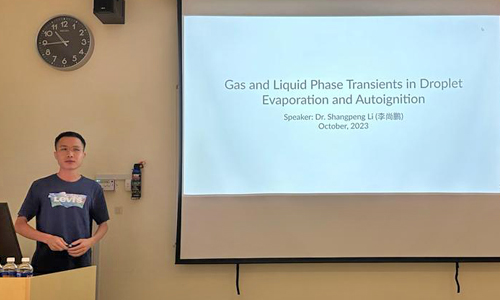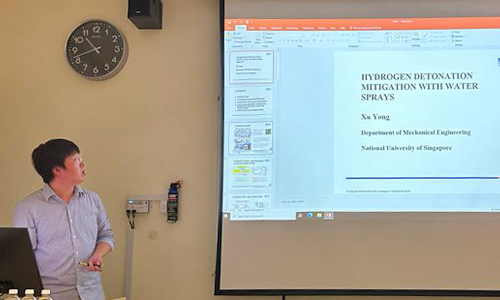Seminar
Hydrogen Detonation Mitigation with Water Sprays |
| 9 October 2023, Monday, 10:00 - 10:30am | Speaker: Dr. Xu Yong, Research Fellow, Department of Mechanical Engineering, NUS |
| Venue: Seminar Room 8D-1, Level 8, Temasek Laboratories | Event Organiser Host: Dr. Huang Xin |
|
ABSTRACT |
Understanding of hydrogen detonation dynamics with dispersed phases is of great significance to practical hydrogen explosion inhibition techniques. The Eulerian─Lagrangian method with gas-droplet/particle two-way coupling is used to predict the detonation wave (DW) in dilute water sprays. Pulsating detonation in stoichiometric hydrogen/oxygen/argon gas with water sprays are first studied with a one-dimensional configuration. The pulsating phenomenon originates from the interactions between gas dynamics, chemical kinetics, and droplet dynamics inside the induction zone. (Combustion and Flame 2022a). In addition, the propagation and extinction of stoichiometric hydrogen/air detonations in fine water sprays are numerically simulated. Extinction analysis is performed with the evolutions of detonation frontal structure, spatial distribution of thermochemical variables and interphase transfer rates. Moreover, the chemical explosive mode analysis reveals that for stable detonation, thermal runaway dominates behind the Mach stem, while chemical propensities of auto-ignition and thermal runaway appear alternately behind the incident wave. (Physics of Fluids 2021). Furthermore, interactions between a propagating hydrogen/air detonation wave and circular water cloud are studied. Leeward re-detonation is analysed from unsteady evolutions of gas and liquid droplet quantities. The detonation is re-initiated by a local hot spot from shock focusing of upper and lower diffracted detonations. Mechanism analysis confirms that velocity difference (momentum exchange) dominates the formation of large-scale vortices, corresponding to Kelvin–Helmholtz instability. (Combustion and Flame 2022b) |
| ABOUT THE SPEAKER |

Dr. Xu Yong obtained his PhD degree from National University of Singapore in 2022 and now works in the Department of Mechanical Engineering, National University of Singapore as a postdoctoral researcher, focusing on Hydrogen Detonation Mitigation by Water Sprays with the Eulerian-Lagrangian method. |

Gas and Liquid Phase Transients in Droplet Evaporation and Autoignition |
| 9 October 2023, Monday, 10:30 - 11:00am | Speaker: Dr. Shangpeng Li, Research Fellow, Department of Mechanical Engineering, NUS |
| Venue: Seminar Room 8D-1, Level 8, Temasek Laboratories | Event Organiser Host: Dr. Huang Xin |

ABSTRACT |
Research into the evaporation, ignition, and burning of individual droplets enhances our understanding of complex spray combustion processes. It is known that droplet evaporation is influenced by transient factors, including gas-vapor accumulation and droplet temperature variations, especially during the initial stages. This influence becomes particularly pronounced under elevated pressure conditions and substantial disparities between the initial and equilibrium droplet temperatures. A comprehension of these transient effects is crucial for developing advanced combustion systems prioritizing reliability, efficiency, and pollution control. In this presentation, we provide a theoretical analysis exploring transient effects arising from gas-phase transient diffusion and variations in droplet temperature on pure droplet evaporation and autoignition processes. We begin by extending the classical quasi-steady model to incorporate the gas-vapor transient accumulation effect by considering the evolution of the evaporating boundary layer attached to the droplet surface. Subsequently, we integrate the influence of droplet temperature variation into the analysis based on the assumption of rapid mixing in the liquid phase. Comparison with extensive numerical simulations demonstrates that our theory accurately accounts for both gas and liquid transient effects, and the theoretical results successfully predict droplet lifetimes and the critical ignition limits of droplets. Therefore, our research expands the applicability of the classical quasi-steady theory, providing an intuitive and physically meaningful analysis that enhances our fundamental understanding of spray combustion. |
| ABOUT THE SPEAKER |
|
|




 Dr. Shangpeng Li obtained his Ph.D. degree from Tsinghua University, China in 2021. He is currently working as a postdoc in the Department of Mechanical Engineering, National University of Singapore. During his Ph.D., he primarily studied ignition, flame structure and flame stabilization in boundary-layer flows. His doctoral dissertation received the Outstanding Doctoral Dissertation Award from Tsinghua University. He also received the Distinguished Paper Award at the 38th International Symposium on Combustion. Dr. Li’s current research focuses on theoretical analysis and numerical modelling of droplet and spray combustion. His research aims to contribute to the development of advanced combustion systems that prioritize reliability, efficiency, and pollution control.
Dr. Shangpeng Li obtained his Ph.D. degree from Tsinghua University, China in 2021. He is currently working as a postdoc in the Department of Mechanical Engineering, National University of Singapore. During his Ph.D., he primarily studied ignition, flame structure and flame stabilization in boundary-layer flows. His doctoral dissertation received the Outstanding Doctoral Dissertation Award from Tsinghua University. He also received the Distinguished Paper Award at the 38th International Symposium on Combustion. Dr. Li’s current research focuses on theoretical analysis and numerical modelling of droplet and spray combustion. His research aims to contribute to the development of advanced combustion systems that prioritize reliability, efficiency, and pollution control.